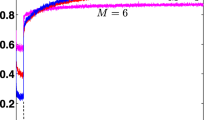Abstract
The fast Fourier transform-moving average (FFT-MA) is an efficient method for the generation of geostatistical simulations. The method relies on the calculation of a filter operator based on the covariance function of interest and the convolution of the filter with a white noise, to generate multiple realizations of spatially correlated variables. In this work, a revisited mathematical formulation of the FFT-MA method, with the exact expression of the filter, is presented. The proposed derivation of the filter is based on the Wiener–Khinchin theorem and the application of the Fourier transform in a discrete domain. In the specific case of white noise, the proposed formulation leads to the same expression of the traditional algorithm. However, the method can be applied to other types of noise. The proposed technique allows the calculation of a specific filter that imposes an exact covariance function on the noise. Therefore, the experimental covariance function is exactly equal to the theoretical one, which is not the case for many common simulation techniques due to the limited sample size. Applications of the FFT-MA method to synthetic and real data sets, including exact interpolation, hard data conditioning and correlated simulations from cross-correlated noises, are also presented.







Similar content being viewed by others
References
Alabert F (1987) The practice of fast conditional simulations through the LU decomposition of the covariance matrix. Math Geol 19(5):369–386
Arfken G, Weber H, Harris F (2011) Mathematical methods for physicists: a comprehensive guide. Elsevier, Amsterdam
Armstrong M, Galli A, Beucher H, Loc’h G, Renard D, Doligez B, Eschard R, Geffroy F (2003) Plurigaussian simulations in geosciences. Springer, Berlin
Bourgault G, Marcotte D (1991) Multivariable variogram and its application to the linear model of coregionalization. Math Geol 23(7):899–928
Bourgault G, Marcotte D (1993) Spatial filtering under the linear coregionalization model. In Geostatistics Tróia’92. Springer, Berlin, pp 237–248
Brooker PI (1985) Two-dimensional simulation by turning bands. Math Geol 17(1):81–90
Davis MW (1987) Production of conditional simulations via the LU triangular decomposition of the covariance matrix. Math Geol 19(2):91–98
de Figueiredo LP, Grana D, Bordignon FL, Santos M, Roisenberg M, Rodrigues BB (2018) Joint Bayesian inversion based on rock-physics prior modeling for the estimation of spatially correlated reservoir properties. Geophysics 83(5):M49–M61
Deutsch C, Journel AG (1992) GSLIB: geostatistical software library and user’s guide. Oxford University Press, Oxford
Doyen P (2007) Seismic reservoir characterization: an earth modelling perspective. Education tour series. EAGE Publications, Amsterdam
Doyen P, Psaila D, Strandenes S (1994) Bayesian sequential indicator simulation of channel sands from 3-d seismic data in the oseberg field, Norwegian north sea. In: SPE annual technical conference and exhibition 1994, society of petroleum engineers, pp 1–15
Ersoy A, Yünsel TY (2006) Geostatistical conditional simulation for the assessment of the quality characteristics of Cayırhan lignite deposits. Energy Explor Exploit 24(6):391–416
Gómez-Hernández JJ (2005) Geostatistics. In: Rubin Y, Hubbard SS (eds) Hydrogeophysics. Springer, Dordrecht, pp 59–83
Grana D, Mukerji T, Dovera L, Della Rossa E (2012) Sequential simulations of mixed discrete-continuous properties: sequential Gaussian mixture simulation. In: Abrahamsen P, Hauge R, Kolbjørnsen O (eds) Geostatistics Oslo 2012. Springer, Dordrecht, pp 239–250
Hunger L, Cosenza B, Kimeswenger S, Fahringer T (2014) Random fields generation on the GPU with the spectral turning bands method. In: Euro-Par 2014 parallel processing. Springer International Publishing, Cham. ISBN: 978-3-319-09873-9, 656–667
Journel A, Huijbregts C (1978) Min Geostat. Academic Press, London; New York
Journel AG, Gomez-Hernandez JJ (1993) Stochastic imaging of the Wilmington clastic sequence. SPE Form Eval 8(1):33–40
Le Ravalec M, Noetinger B, Hu LY (2000) The FFT moving average (FFT-MA) generator: an efficient numerical method for generating and conditioning Gaussian simulations. Math Geol 32(6):701–723
Le Ravalec-Dupin M, Da Veiga S (2011) Cosimulation as a perturbation method for calibrating porosity and permeability fields to dynamic data. Comput Geosci 37(9):1400–1412
Le Ravalec-Dupin M, Hu L, Roggero F (2008) Reconstruction of existing reservoir model for its calibration to dynamic data. Earth Sci Front 15(1):176–186
Liang M, Marcotte D, Shamsipour P (2016) Simulation of non-linear coregionalization models by FFTMA. Comput Geosci 89:220–231
Marcotte D, Allard D (2018) Half-tapering strategy for conditional simulation with large datasets. Stoch Environ Res Risk Assess 32(1):279–294
Oliver DS (1995) Moving averages for Gaussian simulation in two and three dimensions. Math Geol 27(8):939–960
Pyrcz MJ, Deutsch CV (2001) Two artifacts of probability field simulation. Math Geol 33(7):775–799
Soares A (2001) Direct sequential simulation and cosimulation. Math Geol 33(8):911–926
Srivastava RM (1992) Reservoir characterization with probability field simulation. In: SPE annual technical conference and exhibition, society of petroleum engineers, pp 330–330
Tran T, Deutsch C, Xie Y (2001) Direct geostatistical simulation with multiscale well, seismic, and production data. In: SPE annual technical conference and exhibition 2001, Society of Petroleum Engineers, pp 1–8
Wackernagel DH (2003) Multivariate geostatistics: an introduction with applications, vol 3. Springer, Berlin
Wiener N (1966) Extrapolation, interpolation, and smoothing of stationary time series with engineering applications. M.I.T. Press, Cambridge
Yang X, Zhu P (2017) Stochastic seismic inversion based on an improved local gradual deformation method. Comput Geosci 109:75–86
Acknowledgements
The authors acknowledge Petrobras, the School of Energy Resources of the University of Wyoming and the IFP Energies nouvelles for the support.
Author information
Authors and Affiliations
Corresponding author
Rights and permissions
About this article
Cite this article
de Figueiredo, L.P., Grana, D. & Le Ravalec, M. Revisited Formulation and Applications of FFT Moving Average. Math Geosci 52, 801–816 (2020). https://doi.org/10.1007/s11004-019-09826-4
Received:
Accepted:
Published:
Issue Date:
DOI: https://doi.org/10.1007/s11004-019-09826-4




